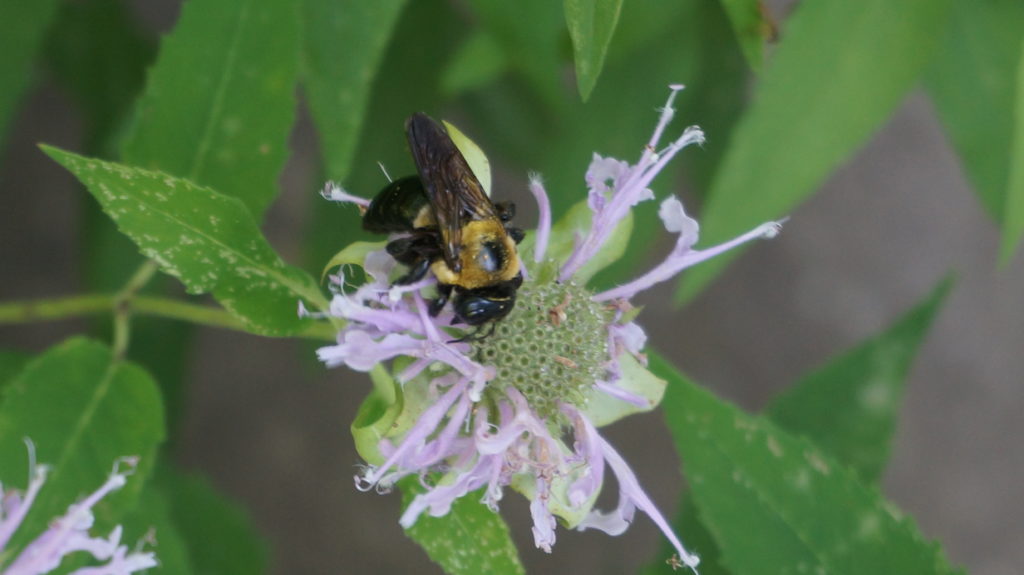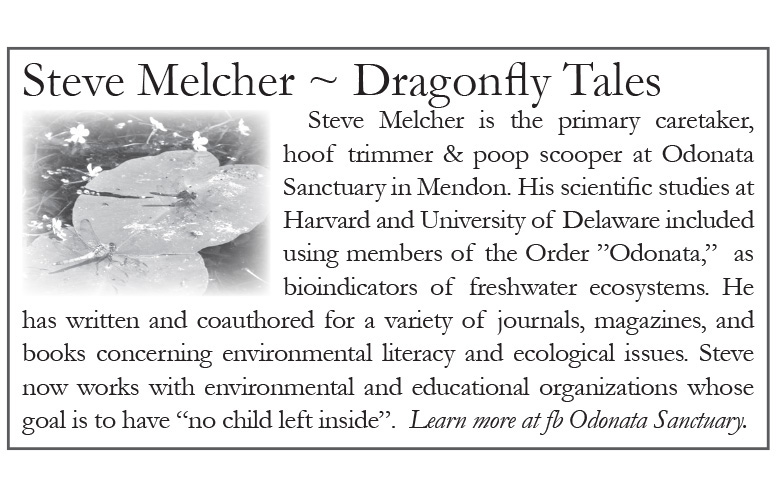Dragonfly Tales: The importance of habitat diversity
by Steve Melcher –
“The greatest threat to organisms and biodiversity is habitat loss.” S.A. Melcher 1989
Habitat Diversity
Odonata Sanctuary is home to over 100 acres of diverse habitats. One of our main missions at the sanctuary is to maintain and create habitats for specific species. The habitats are as diverse as anywhere in New York state.
Grassland birds
We have 30 acres of grassland habitat that we mow every other year, specifically for ground nesting birds. Grassland habitats are disappearing on a national scale at an alarming rate. Bobolinks and Meadowlarks have successfully reared their young here in our grassland sanctuary. These birds, along with Dicksissels, are disappearing because of grassland habitat loss. Farmers today may mow their fields for hay two or three times in a season. Unfortunately, many times they’re mowing right over prime nesting sites or the nests themselves. These are the very insectivorous birds that farmers encouraged before chemical companies convinced most of them that they needed to use insecticides to control insect pests. We time our mowing to occur early in the season before the birds arrive and later in the summer when we are sure the birds have fledged. We selectively mow our fields to remove the invasives like Autumn Olive and multiflora-rose and encourage patches of important pollinating and food source plants like the ‘food for kings,’ the milkweed. I encourage all of you to start a milkweed patch. No matter how small, you’ll be spreading seeds for the plant that is necessary for the Monarch Butterfly’s survival. The unmown meadows provide habitat for other beneficial native insects as well. The Virginia Ctenucha (Ctenucha virginica) caterpillars and other species of butterflies and moths feed on the grasses and the adults are prolific pollinators.
Cavity nesters
Half of all birds nest in tree cavities. Cavity nesters are birds that nest in holes. Some, like the bluebird, depend on woodpeckers to do the house construction for them. When the juices are flowing, woodpeckers may create five or six holes and only use one. Cavity nesters, like our state bird, the Eastern Bluebird, were disappearing until a concerted effort of concerned citizens started building nest boxes to replace the lost nesting habitat. The bluebird’s decline can directly be correlated to a loss of nesting habitat found in older apple orchards. We’ve lost many of our apple orchards in upstate New York and the bluebirds along with them. Pesticides kill insects indiscriminately. Those insects are a food source for the woodpecker house builder. Fewer woodpeckers, fewer holes. Fewer holes, fewer nest sites. Fewer nest sites.. Our bluebird trail currently has over sixty nest boxes successfully fledging bluebirds, tree swallows, chickadees and house wrens. Our plan is to have 100 nest boxes on our trail that will be monitored by locals scouts and young naturalists.Hawthorn Orchard
I have aerial photos from the 40’s showing the land mostly in hay and hamburgers. Many acres were sectioned off with barbed wire to contain cows. An interesting and ecologically beneficial remnant of those grazing grass eaters is our 15-acre Hawthorn Orchard. A Hawthorn Orchard is the result of the selective eating habits of the cows. Over several decades, if the pastures are un-mowed and only grazed by bovines, hawthorn trees can grow to 30-40 feet. The spines on the hawthorns and locusts deter the cows from grazing the plants to the ground. As the hawthorns grow taller, the undergrowth gets eaten by the cows and the trees provide shade. However, if the overhead canopy closes to a point where there is complete shade, the chances for the succession of other plant species is reduced. On our land, cow chattel were abandoned in the 60’s. The ecological benefit is a lower carbon footprint for the land and the hawthorns trees are providing an excellent source of nectar for pollinators. The pollinating insects, attracted to the fragrant blossoms, provide an excellent source of food for warblers! When the hawthorns are in bloom in the spring, neotropical migrants move in for a fruit fly feeding frenzy. If you stand on the trail that runs through the hawthorn orchard when the aroma of blooming buds abounds and there is an audible hum of insect industriousness, you may find yourself promoted to colonel, as I was this year, by having one of many species of warblers poop on your shoulder. This spring we were visited by Tennessee Warblers, Bay-breasted, Wilson’s, Cape Mays and many other species without the onset of ‘warbleneck’ caused by looking high into the canopy through heavy binoculars.

Hardwoods
In addition to the Hawthorn Orchard, the land is fortunate to have climax forests consisting of Oak/Hickory and Maple/Beech. In the 40 acres of the ‘Woodpecker Woods’, we have left the old trees standing to provide homes for the prodigious Pileated and other woodpeckers. The hickory nuts are a favorite food of the wild turkeys in the area.
A word about Invasives
We have made a concerted effort to rid the land of invasives and have done a very good job of keeping Purple Loosestrife (Lythrum salicaria) at bay. Others, like multiflora rose (Rosa multiflora) and garlic mustard (Alliaria petiolata) are proving to be more difficult. Keep in mind, like the glyphosate promoted for use by farmers today, most of these invasives were imported to initially serve as natural fences and food sources for wildlife. But like the kudzu of the south, which was imported as a miracle food source and cover crop, we’re finding these plants a threat to native habitats.
Planting for Pollinators
In addition to providing habitat for medicinal plants through United Plant Savers, we participate in the National Pollinator and New York State Pollinator Awareness programs. We have encouraged existing native pollinating plants and plant those missing that were once here. We’re ‘reintroducing’ plants that once grew here. Many have multiple benefits. Besides being a food source for butterflies, spicebush, for instance, is used as a “blood purifier” and for sweating, colds, rheumatism and anemia. Settlers used a twig tea to treat colds, fevers, worms, gas and colic and bark tea to expel worms, for typhoid fevers and a diaphoretic. We’ve created a Spicebush trail along which the scent of Lindera benzoin adds to the festival of butterflies and birds that benefit from this native plant.

Willow Pond
The jewel of the sanctuary is a three-acre, self-sustaining, spring-fed pond, dug to a depth of 50 feet. The pond has a story all of its own reminiscent of the movie ‘Cocoon’. Once stocked with over 100 trout every year, Willow’s Pond, was used by the former owners, the Taylors for ‘fly fishing fun’ for over 20 years. The pond contains small and largemouth bass, several species of bluegill and catfish, Weyward the Water Wizard, many amphibians and of course several species of our namesake: dragonflies. I’ll write more about Taylor Pond LTD in the future.
Wetland
Although extinction is a natural phenomenon, it occurs at a natural “background” rate of about one to five species per year. Scientists estimate we’re now losing species at up to 1,000 times the background rate, with literally dozens going extinct every day. The current amphibian extinction rate may range from 25,039 to 45,474 times the background extinction rate. Frogs, toads, and salamanders are disappearing primarily because of habitat loss. Wetlands have experienced the greatest loss in acreage over the past 100 years. We plan to install permanent shallow ponds in our ‘Lower Loop’ just below ‘Cedar Cliff’. This will provide habitat for birds and amphibians as well as migrating waterfowl. There are other vernal ponds as well. Vernal or Ephemeral ponds are short lived ponds providing a habitat for certain species of dragonflies and an abundance of amphibians. These are the ponds that are filled with the delightful cacophony of spring peepers, wood frogs and so many other creatures who depend on this special habitat. There are several streams that run the length of the property. One leads to Irondequoit Creek which eventually flows into Lake Ontario through the bay. One year we found a Chinook salmon washed up on the bank. Imagine salmon seeking fertile grounds, travelling miles upstream through so many obstacles to lay their eggs.
There is about a thirty-acre section that was formerly drained by the use of clay drainage tiles during a time when wetland habitats weren’t as well understood and farmers were encouraged to drain the wetland and plant land from ‘edge to edge’. Today, we know more about the importance of wetlands as nursery grounds for fish and fowl alike, sponges for storm waters and export factories of food for other habitats. We are crushing those tiles where celery, subsidized corn and soybeans once grew, in hopes that the land will again become the former glory of a wetland habitat. Oceanography was my original field of study, but I switched to freshwater ecology in graduate school, the former field being flooded with folks finding work only for big oil. The wetlands of Odonata Sanctuary are probably the most precious to me. The sedges with their edges and the rushes that are round…and the willows, found where water abounds. At Odonata Sanctuary there is a swamp as well as a freshwater marsh. Most folks use the terms interchangeably. I’ll leave you with a way to remember the simple difference. ‘A marsh has grass and a swamp has trees, if you walk through either, you’ll get wet up to your knees’. Or, ‘A swamp has trees and a marsh has grass, if you walk through either you’ll get wet up to your….knees.’
Farmland and Rescued Critters
We still have an area reserved for farming where we hope to replace our sorely missed CSA farmer, James of ‘Buzz’s Garden’ fame. We currently grow several kinds of currants and berries. Fifteen acres is being groomed for future hemp growth with seeds provided by and encouragement from the state of NY. We grow mushrooms in one area and there is of course the medicinal herbs we grow as part of our membership in the United Plant Savers. The farmland of old provided habitat not just for the crops, but for many species of wildlife as well. Insect-eating birds, like the bluebirds and meadowlarks, were beneficial to the farmer. Today’s monoculture has created an environment flush with harmful chemicals. The unharvested and subsidized corn and soybean monocultures have also encouraged a deer population explosion.

We’re fortunate to live in an area that supports and encourages local farmers to hold onto their land through tax relief policies and conservation easements. Houses are the last thing a farmer can grow on his land. We’re seeing more and more housing developments and McMansions because the newest generation of the family farm isn’t interested or can’t afford the hard work of farming life. Many of us moved to the country to be closer to the land; a land with a rich diversity of habitats. In the words of Will Rogers and Mark Twain ‘Land…they’re not making any more of it.’ Please support your local farmers and encourage them to maintain a healthy diversity of habitats. Buy local when you can and support the farmer who maintains a healthy diversity of natural habitats on his precious land.
